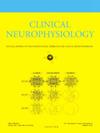Pallidal activity in Parkinson’s disease patients with intraoperative dyskinesias
IF 3.7
3区 医学
Q1 CLINICAL NEUROLOGY
引用次数: 0
Abstract
Objective
We aimed to investigate the differences in activity of globus pallidus externus (GPe) and internus (GPi) in Parkinson’s disease (PD) following levodopa uptake in comparison with the unmedicated state.
Methods
We compared single unit activity of the GPe and the GPi of two parkinsonian patients who exhibited levodopa-induced dyskinesias (LID) during deep brain stimulation surgeries with three unmedicated patients with comparable levodopa response. We focused on discharge rates, firing patterns and oscillatory properties of the neurons.
Results
We observed that the majority of the GPi neurons fired less frequently and regularly following levodopa administration, but no uniform differences were found in the GPe. We found no units oscillating in low beta (12–20 Hz) in either state, but several GPi cells demonstrated oscillatory discharge in 4–5 Hz and 20–30 Hz on medication.
Conclusions
Our findings suggest that the GPi is more uniformly responsive to levodopa than the GPe. They also point towards the plausible need for revisiting the model of beta oscillations’ emergence as a result of synchronized bursting in the STN-GPe-GPi network.
Significance
Our study investigates the effect of dopamine-replacement therapy with levodopa on the GPe and GPi at the single-cell level, contributing to understanding the PD pathophysiology.
帕金森病患者术中运动障碍的苍白球活性
目的探讨左旋多巴摄取后帕金森病(PD)患者苍白球外(GPe)和内(GPi)活动与未用药状态的差异。方法比较脑深部电刺激手术中2例左旋多巴诱发运动障碍(LID)的帕金森病患者与3例左旋多巴反应相似的未用药患者GPe和GPi的单位活性。我们关注的是放电速率、放电模式和神经元的振荡特性。结果左旋多巴给药后,大部分GPi神经元放电频率和规律性降低,但GPe无明显差异。我们发现在两种状态下,没有单位在低β (12-20 Hz)下振荡,但一些GPi细胞在药物治疗后表现出4-5 Hz和20-30 Hz的振荡放电。结论GPi对左旋多巴的反应比GPe更均匀。他们还指出,有必要重新审视由于STN-GPe-GPi网络同步爆发而产生β振荡的模型。意义本研究探讨左旋多巴替代多巴胺治疗对单细胞水平GPe和GPi的影响,有助于了解PD的病理生理。
本文章由计算机程序翻译,如有差异,请以英文原文为准。
求助全文
约1分钟内获得全文
求助全文
来源期刊

Clinical Neurophysiology
医学-临床神经学
CiteScore
8.70
自引率
6.40%
发文量
932
审稿时长
59 days
期刊介绍:
As of January 1999, The journal Electroencephalography and Clinical Neurophysiology, and its two sections Electromyography and Motor Control and Evoked Potentials have amalgamated to become this journal - Clinical Neurophysiology.
Clinical Neurophysiology is the official journal of the International Federation of Clinical Neurophysiology, the Brazilian Society of Clinical Neurophysiology, the Czech Society of Clinical Neurophysiology, the Italian Clinical Neurophysiology Society and the International Society of Intraoperative Neurophysiology.The journal is dedicated to fostering research and disseminating information on all aspects of both normal and abnormal functioning of the nervous system. The key aim of the publication is to disseminate scholarly reports on the pathophysiology underlying diseases of the central and peripheral nervous system of human patients. Clinical trials that use neurophysiological measures to document change are encouraged, as are manuscripts reporting data on integrated neuroimaging of central nervous function including, but not limited to, functional MRI, MEG, EEG, PET and other neuroimaging modalities.
 求助内容:
求助内容: 应助结果提醒方式:
应助结果提醒方式:


